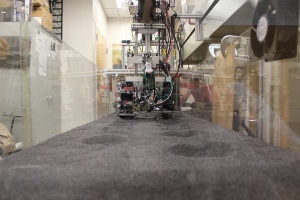Nov 14 2013
Kingsbury, a doctoral candidate in physics and researcher in the Complex Rheology and Biomechanics (CRAB) Lab at Georgia Tech, is working with Associate Professor Daniel Goldman and Stephen Gatesy at Brown University to build a “Robosaur.” The idea is to study how dinosaurs walked, with the goal of using the secrets of the past to enhance the future. Their project is up for funding on Georgia Tech Starter, a new peer-reviewed crowd-funding website.
 The Robosaur Walks in a tank of poppy seeds in the Complex Rheology and Biomechanics (CRAB) Lab. Photo courtesy of Mark Kingsbury.
The Robosaur Walks in a tank of poppy seeds in the Complex Rheology and Biomechanics (CRAB) Lab. Photo courtesy of Mark Kingsbury.
What is the Robosaur? What are you trying to do with it?
The Robosaur is a mobile robot that lets us study how dinosaurs walked. We’re building this robotic model to be able to analyze how dinosaurs walked from a simple perspective. We have a lot of information about their tracks, but don't yet have a technique for unearthing the information buried within the tracks. (That's where the Robosaur comes in.)
Why do we want to know how dinosaurs walked?
Understanding how they moved can help us build better robots and improve how they move in different terrain. For example, in the Fukoshima nuclear disaster, we couldn’t send humans into some rescue efforts because it was too dangerous. Robots that can navigate that kind of complex terrain could help with search and rescue or recovery efforts in these kinds of environments.
What material do you use to study how the Robosaur walks?
We use poppy seeds. They behave similarly to natural sand or other terrain, and it’s a nice, light material that’s kind to robots — if the seeds get into the gears, they won’t be harmful like sand or glass could.
Is the Robosaur modeled after a specific dinosaur?
It's actually modeled after a bird, the guinea fowl, which serves as a good model in place of an actual dinosaur.
What do you hope to see robots be able to do in your lifetime?
I’m interested in advancing robotics in how they interface with humans. For example, when someone who lost a limb could get an prosthetic part to replace what was lost. I think that’s something that’s achievable.
What’s special about fundraising through Starter?
It’s another source of funding at a time when you need a diverse portfolio, but it also lets people invest directly in science. It lets researchers reach out directly to people, who can become a part of science and become more science-literate, which can only lead to good things. The highest level of funding on Starter even gets you invited to our lab to help do some research with us.